Your Tri Bike Buying Plans for 2022
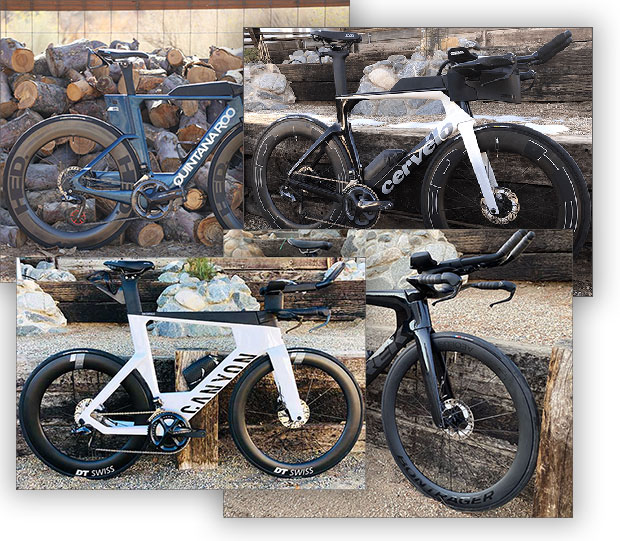
Are you buying a tri bike this year? New or pre-owned? How much wll you spend? I've tracked your answers to these questions over the past decade. The results of this polling will validate what some of you believe; might frustrate some of you; but mostly I hope it will contextualize what the leading tri bike bike brands offer to you for sale.
My plan is to condense and present what you have taught and told me over the years and the chart below displays what this community reported to me at the start of the 2011 season; then at the very beginning of the COVID pandemic, when none of us really had much of an inkling what the pandemic would mean to us all, nor how long it would last…
…and you just finished answering the same question again, as we head into the 2022 buying season.
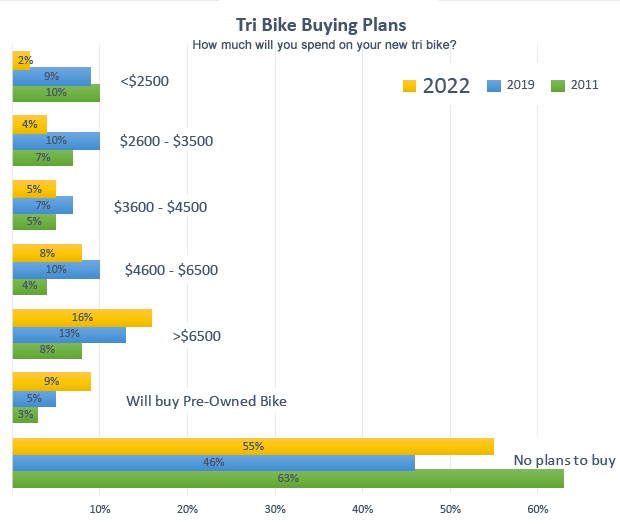
The first thing I hope you’ll glean from this data is that we all had high hopes for a 2019 season and planned our tri bike purchases accordingly. Triathlon worldwide, but mostly in the United States, boomed from 1999 to 2011; swooned from 2012 to 2017; bottomed out in 2018; and began to modestly grow again in 2019. Or, would have. The 2019 poll suggests that many of you were prepared to buy tri bikes.
As you see in the chart just below 2019 should have been a robust tri bike selling year for the brands. But the pandemic changed things. Tri bikes are in that product class – like triathlon wetsuits, deep wheels and aero helmets – that require a race on the horizon in order to validate the purchase. As the race season began to crater, so did plans to buy all these products.

We can see this as we look at the signals you gave on your intended behavior. It’s not that bikes stopped selling; it’s that tri bikes stopped selling. Below is how your bike purchase behavior changed (see the 2020 poll results, taken smack in the middle of the pandemic, and the results of the same poll taken within the last month).
As we see, your intention to purchase a bike did not diminish; youre purchase plan simply moved from tri bike to gravel bike, or smart bike, or anything you could ride that did not demand a race.
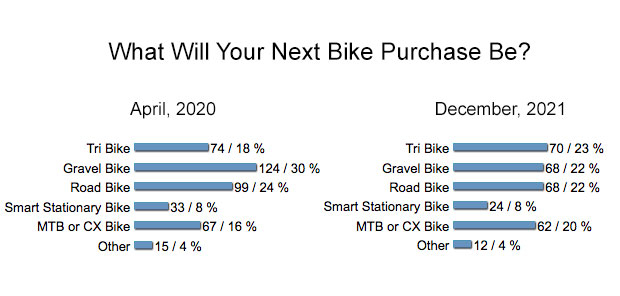
But your interest has begun to switch back to tri. While your intention to buy a tri bike fell to a distant third among bike types mid-pandemic (almost twice as many of you intended to purchase a gravel bike versus a tri bike back then), the tri bike is now (narrowly) the purchase more of you will make among the various bike styles for sale.
Hey, Big Spender
Here is what will disappoint a number of you – particularly the vocal cohort that reliably complains of high-priced product. The number of you who intend to buy a new bike and who’re prepared to pay $2,500 or less has almost vanished. Partly this is because (the aggregate) you realize that there just aren’t many bikes for sale in this price range anymore. Mostly it’s because those bikes just don’t sell. There is a minimum feature set triathletes will accept on their tri bikes, and while historically inexpensive bikes like the Fuji Aloha fit into budgets, they just didn’t sell well enough to survive.

There are bikes that perhaps should sell, but don’t sell, and you could class 650c bikes in small sizes among them. In many or most cases the market determines the price or – more precisely in this case – the market determines the features and the features dictate the price.
What our polls reveal is a move not just out of the below-$2,500 range, but a move into the halo-price range. In the chart below, it’s not that 16 percent of you intend to buy a bike selling for at least $6,500. Remember, 55 percent of you don't intend to buy a tri bike this year, and 9 percent a pre-owned tri bike. If you take this 36 percent of folks intending to buy a new tri bike this year, and scale up the percentages, it breaks down this way: of those of you who will buy a tri bike in 2022, a whopping 44 percent will spend at least $6,500 on your new tri bike. Only 8 percent of you will spend $2,500 or less. You-all who’ll spend between $2,500 and $6,500 make up 48 percent, only slightly higher than the number of you who intend to buy these halo-priced bikes.

Whenever I query bike makers who sell a range of tri bikes spanning these price categories, I’m almost always surprised by what the best-selling models are. They tend to be the higher-priced models. Perhaps this is why Trek’s Speed Concepts no longer include the lower-priced aluminum-frame models. It’s not that Trek is elitist, or money-grubbing, but because the market (you) has spoken.
The Pro's Closet
Then we get to pre-owned, and this is all about The Pro’s Closet. Certainly a part of the move here is the disappearance of the under-$3,200 new tri bike. This affordability gap has made the pre-owned market a necessity.
But if you ask the folks at The Pro’s Closet what their average selling price is, it’s shot way up over the past 2 years. Folks aren’t buying new $4,000 bikes for a pre-owned $2,000 price tag. They’re spending $4,000 or $5,000 on bikes that cost $8,000 or $9,000 new.

But it’s not just the products themselves you see on The Pro’s Closet's portal; it’s the whole process of sell and buy. If you marry the data from our polling to the logistics changes in our industry – most notably the movement to and from customers of boxless complete bikes – The Pro’s Closet stands to gain the most from a tailwind pushing the ease of transactions on both the buy and sell side. Add in the safety of a factory-inspected pre-owned bike, and the searchable database of thousands from which to choose, and The Pro’s Closet is looking more and more like a mini-Amazon.
Based on the polling you all apparently have noticed. The intention to purchase pre-owned tri bikes has tripled over the last decade, and of those who intend to buy a tri bike this year 1 out of every 5 will invest in a pre-owned bike. To put this another way, the top-5 selling tri bike "brands" today are probably Canyon and Cervelo in a dead heat for 1st place; Quintana Roo and Trek in a dead heat for 3rd place; with The Pro's Closet either just in front of, or not far behind, Trek and QR (depending on how many of the pre-owned bikes you'll buy will come from The Pro's Closet).
Temper Enthusiasm With Caution
Before I get too far over my front wheel, this robust 2022 tri bike sale/purchase season has to overcome two potential roadblocks. First is a possible resurgence of the pandemic. The Omicron variant appears to be like flash paper: quick to burn, quick to burn out, but not much fire damage. But we didn’t just move from Delta to Omicron. Variants include Alpha, Beta, Gamma, Epsilon, Eta, Iota, Kappa, Zeta, and Mu. And, Lambda (mostly a South American phenomenon). We've been mostly lucky with all these variants, but this virus class isn’t going to stop once we run out of Greek letters.
Second is the supply chain problem, which is a combination of pandemic-shuttered overseas factories; the inability to hire up enough truck drivers; a bottleneck at the ports; a shortage of shipping containers; and no-doubt other factors if which I’m naïve.
These are our known unknowns. But the polling here is not designed to tell anyone what will happen; but to signal to buyers and sellers would is most likely to happen, at least among our readers, if the world catches a break and normal commerce returns.



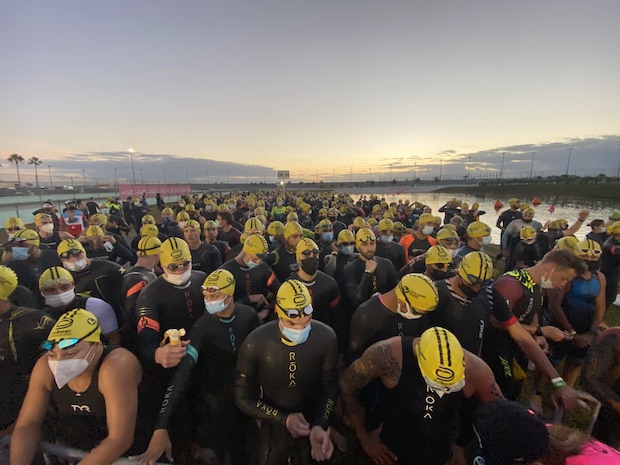
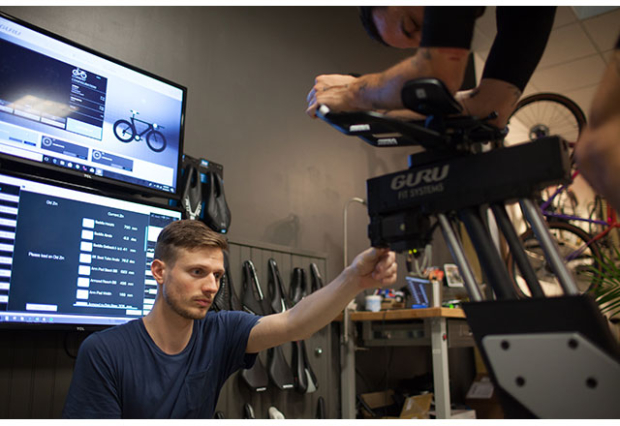
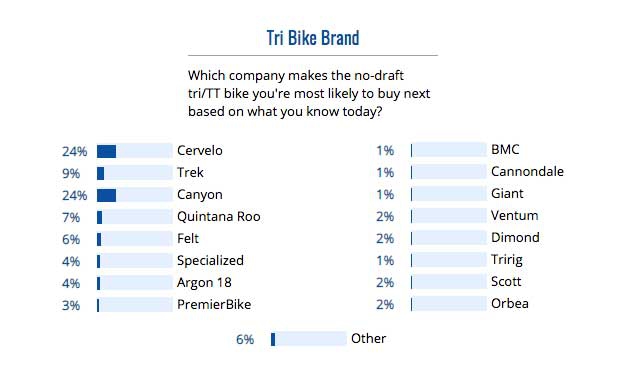

Start the discussion at forum.slowtwitch.com